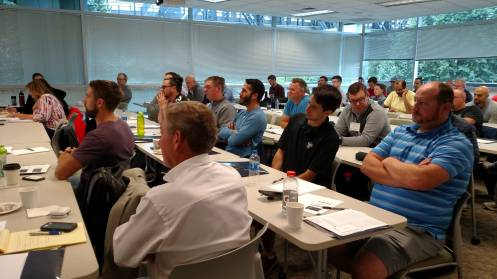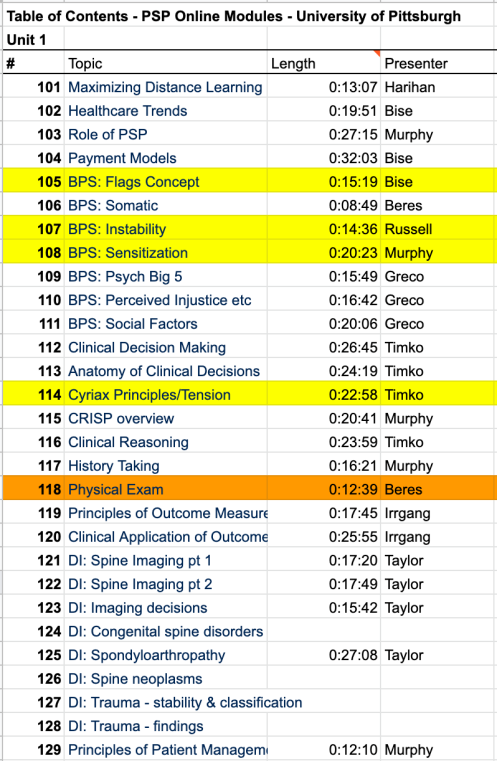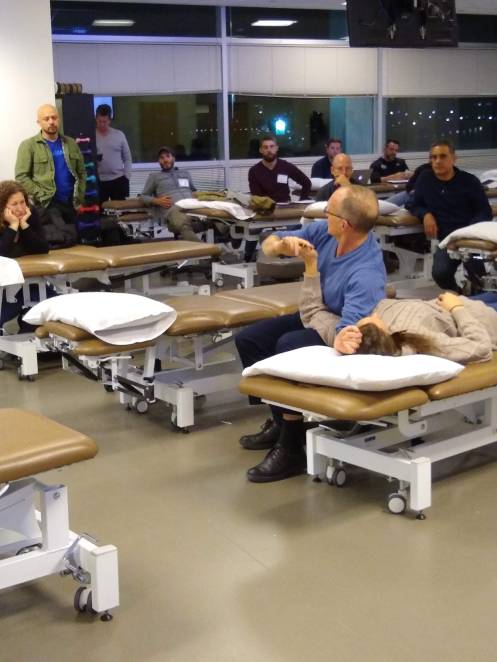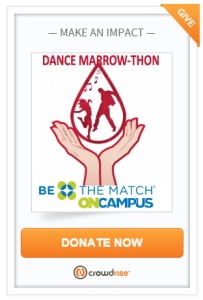
Hi colleagues, students and everyone else! This seems like a good time to do some writing, doesn’t it? It’s hard for me to believe that I last published here in 2017. The beginning of March feels like a lifetime ago, yet somehow that last post still feels recent.
After graduation, I told you about spending a trimester in the Rhode Island Spine Center, learning about the specialty of primary spine care. As you may have gathered from the length and enthusiasm of that post, I decided this was the specialty for me. When the University of Pittsburgh began enrollment for a Primary Spine Practitioner Certification Program, I signed up in the first cohort. My Facebook friends and Twitter followers then endured a year of posts, yet none of that glorious spinal content made its way here. May I now rectify the situation? With thanks to my colleagues Dr. Clark and Dr. Edwards, presenting… the PSP FAQ:
I need to do more research into PSP. What did you like? What didn’t you? What would you suggest knowing before you go in? Does it change your day to day practice?

The strength was improving my clinical efficiency and building my confidence that I’m giving patients complete and relevant information all the time. The team of DCs, DPTs, and PhDs that created the program really designed it around getting the best outcomes in a busy office. In my daily office life, my PSP education guides every aspect of my communication and decision making for all my spine patients.

That means knowing what information to include in paperwork, how to streamline history taking by asking only relevant questions, which physical exam tests will provide practical information, how to form an actionable and comprehensive diagnosis, and matching treatment to findings. Most importantly, I have changed the context of my communications with patients to empower them to take control over the problems they bring to the office. As a bonus, I have a way better understanding of my role in the broader picture of that person’s interactions with medical systems as they attempt to navigate a constellation of services claiming to treat spine problems.
Super! Yes like- I feel like I need more confidence surrounding my clinical decisions, prognosis, goal setting and expected outcomes, etc. Do you feel like you needed to study anything before you went in? How much work per week did it require?
I think that knowing which exam procedures are actually meaningful (lots aren’t), and knowing what treatments they indicate really helps me waste less time. From the patient’s perspective, it likely means fewer instances of those tolerable but unexpected increases in pain after treatment, and less experimentation before finding what works best for them because I was able to predict it from the outset.
YESSS that’s what I want. Like that’s what school should’ve been haha. I was literally thinking about exactly this today – and wondering how to find it when you just plopped it in my lap.

I didn’t feel like I needed to study anything as a prereq, as school and a couple years of experience primed me well. Reading CRISP would be very helpful. Physical therapists were required to have previously completed training in joint manipulation.
The course involves a pretty considerable amount of work. Plan on about 10 hours of online content and reading for each of the four units. There were three months to work through the reading and online content for each in-person weekend. Each unit had a test at the end, and the program included a multi-part examination at its conclusion. We completed a written test, an imaging test, an OSCE-style test with stations for examination and treatment procedures, and finally worked independently through case with a standardized patient in front of a panel of certified peers.
Oh that’s awesome. Do you feel like you would get the same content if you just read the material?

I actually read the material and even worked in Murph’s office for 3 months beforehand, and still learned a lot from the course. Turns out they know a lot of stuff that isn’t in the books. Having a collection of experts together for the program means answering questions and having conversations for a depth of learning far greater than reading alone. Weekends in Pittsburgh were the most fun part of the course, as they naturally involved a mix of learning and spending time with people who share our interests.
Can you say that taking the PSP course has fundamentally changed the way you practice/approach patients?

Surprisingly, yes. The most practical difference is that I’m more time-efficient. The most noticeable difference is that I can give patients a helpful forecast of their trajectory, and I’m very good at handling patients with lots of emotions.
In ways that you weren’t before the course?
Yeah, my communication and my ability to process their emotions without internalizing it all makes work less stressful, honestly. One unit focuses strongly on psychology, beliefs and behaviors that contribute to the experiences of pain, suffering and disability. The same behavioral interventions and concepts of mindfulness actually improved my own responses and coping.
I need me a slice of that. I am also hoping the program helps me to communicate better interprofessionally.
I’ve had some great conversations when the opportunities arise. I used what I learned to teach a dental society about musculoskeletal causes of facial pain, and to talk with surgeons about non-surgical approaches to disc pain. I feel like I improved my overall ability to grasp the experience of spine disorders, the best way to apply what we know about them in an individualized way, and my role in the broader picture of health care.

A multidisciplinary team at the University of Pittsburgh’s Department of Physical Therapy produced the Primary Spine Practitioner program. Learn more or enroll here. You can learn more about Primary Spine Practitioners’ role in Dynamic Chiropractic or in more detail in this journal article.
Brendan McCann, DC has blogged about chiropractic education since his enrollment at New York Chiropractic College in 2012. He practices spine care in Portsmouth, NH– now with video telehealth appointments available on your phone!
Residency is a complicated topic throughout the healthcare world, and its role remains perennially controversial. For new doctors graduating medical school, it is the assumed next step, with almost 80% of medical school graduates completing a residency in their first 4 years as a doctor. Despite being nearly universal among MDs and DOs, Read more…

“You do these rotations and you meet all kinds of people, and as you get to know them, you like them, which means you also have a feeling like they’re an ordinary human being, and the fact that somebody you like is doing something you find pretty cool, you start imagining, well maybe I could do that. The biggest reasons that people choose their fields is they meet people that they like, and they end up wanting to go into that field.” -Atul Gawande
When I wrote last, I left you at the close of my last trimester on school premises, after seeing 250+ patient visits, and earning an honors externship in Providence, RI. In a whirlwind week, I was fresh off of the plane from The National, a huge chiropractic conference put on by the Florida Chiropractic Association. One thing was on my mind: what was I going to do after my upcoming graduation, months away now?
Arrival
I arrived in Providence in my dad’s pickup truck, loaded with the bare essentials. I had arranged a place to live by Skype after finding a roommate-wanted listing on Craigslist, and basically badgering her landlord into letting me show up on three days notice. From my paved and fenced backyard on Federal Hill I realized I’d never been to Providence and never lived in the city- any city! All I had to prepare me was a place and a time: Rhode Island Spine Center, Monday at 9 AM. I set up my bed, made some dinner, and smoothed out my white coat to be ready for the morning.
Rhode Island Spine Center is in an unassuming building at the northern edge of Providence. When North Main Street crosses into the city of Pawtucket, the very first thing you Read more…

Preface: Ten months ago, I graduated and noted that “there is still much more to write!” Yet, the last time that I updated this record of my studies was for my 8th trimester, which I finished in May 2015. I’ve seen the same thing happen with many other blogs by future doctors, and though I swore it wouldn’t happen to Hands in Training, here we are. I kept good notes (including three independent drafts of this post), so let’s resume where we left off, shall we?
Chief among the advantages of attending a rural college is the peaceful and uncomplicated setting. College ratings will tout the connection with nature, the quiet to think and the space to stay fit and healthy. Seneca Falls is one of those rural places, and it turns out that a town of few diversions (and an early finish on Fridays) makes for the ideal blogging conditions. During my final two trimesters of school, I lived in Rochester, NY and Providence, RI, respectively, and there were enough exciting attractions (and obligations) after class and clinic that blog updates fell by the wayside. Ironically, these were some of the best stories of my education!
The summer of 9th trimester was a wild time for me. Read more…
Yesterday, I graduated.
In the cold upstate New York morning, a cloud of students descended on the NYCC campus. Many of the crowd had not been here in as much as a year, other than a pilgrimage for licensing exams. We crowded into a hot back room, draped ourselves in black gowns and caps, lined up, and waited for the music to start.
In all, 94 of us walked the stage to receive our Doctor of Chiropractic degree yesterday. After dedicating ourselves fully to these studies since fall 2012, it was an incredibly relaxed, joyous group.
“You’ve started a movement of commitment, compassion, and excellence,” said student body president Bryan Kent, addressing the class on behalf of himself and the other students still in the thick of their studies. I had sworn I wouldn’t cry, but I admit that I got all misty eyed during his speech. This collective class has led the way in learning on and off campus, teaching those who come after us, improving the school and it’s policies, and involving students in the wider profession. Along the way, I think we unintentionally built a sense of spirit among students that wasn’t there before.
I feel incredibly lucky to have enjoyed the company of this class. As we spread out across the world in our professional lives, I’m proud to say we became doctors together.
Today, I can call myself Brendan McCann, Doctor of Chiropractic.
This won’t be the end of this blog. There is still much more to write! And as always, you can find me on Twitter at @bhmccann.
The final year of chiropractic education centers on the clinical experience, and at NYCC, students move off to one of four school-run clinics around New York State. One, of course, is at the main campus in Seneca Falls. One is on Long Island, where NYCC had its main campus until a move in the early ’90s. Two more are along the I-90 corridor, near the major cities of Rochester and Buffalo.
One full year before the big move, though, T5 students have to decide which city they want to call home during their clinical year. It can be a tough decision, with little information to distinguish between the clinics for those with no geographic preference. Over the past months, I talked with students from each of the locations, asking about about advantages, disadvantages, which students intern there, patient base/case types, how busy it is, mentor clinicians, opportunities, and other considerations. Here’s what I learned from some of my classmates:
Canadians are great. That said, prepare yourself for three years of needling for being our mild-mannered, hockey-loving, snow-tolerant, eh-dropping neighbors to the north. Being from just south of the border, I have no clue about the trials and tribulations of crossing over. So I recruited a friend from the Canadian Chiropractic Club on campus (it’s like a support group), and he is here with a supplementary set of tips based on his first year as a student in the US of A: Read more…
The first ever New York Chiropractic College Dance Marrow-Thon will serve as a fundraiser and awareness event to benefit BeTheMatch.org. Operated by the National Marrow Donor Program, BeTheMatch.org has organized the largest and most diverse marrow registry in the world. Saving lives is their mission and we are here to help. We encourage all faculty, staff, and students of NYCC to raise money, join the national bone marrow registry, and DANCE YOUR FACE OFF!
EVENT DATE: JUL 24, 2015
We may be a small community, but we can have an incredible impact. We all Read more…
 Short of graduation, there is no landmark in chiropractic college more highly anticipated than the beginning of 8th trimester. It is the K2 to graduation’s Everest, the delayed opening to graduation’s snow day, the Peyton to graduation’s Brady, the table wine to a graduation’s Cabernet Sauvignon. That is to say, not the pinnacle, but still pretty outstanding.
Short of graduation, there is no landmark in chiropractic college more highly anticipated than the beginning of 8th trimester. It is the K2 to graduation’s Everest, the delayed opening to graduation’s snow day, the Peyton to graduation’s Brady, the table wine to a graduation’s Cabernet Sauvignon. That is to say, not the pinnacle, but still pretty outstanding.
Having just completed T8 myself, I can say that this anticipation is well deserved. We transitioned quite dramatically from spending 24 hours in lecture halls in each week of T7 to spending as many hours in treatment rooms this semester. Read more…



